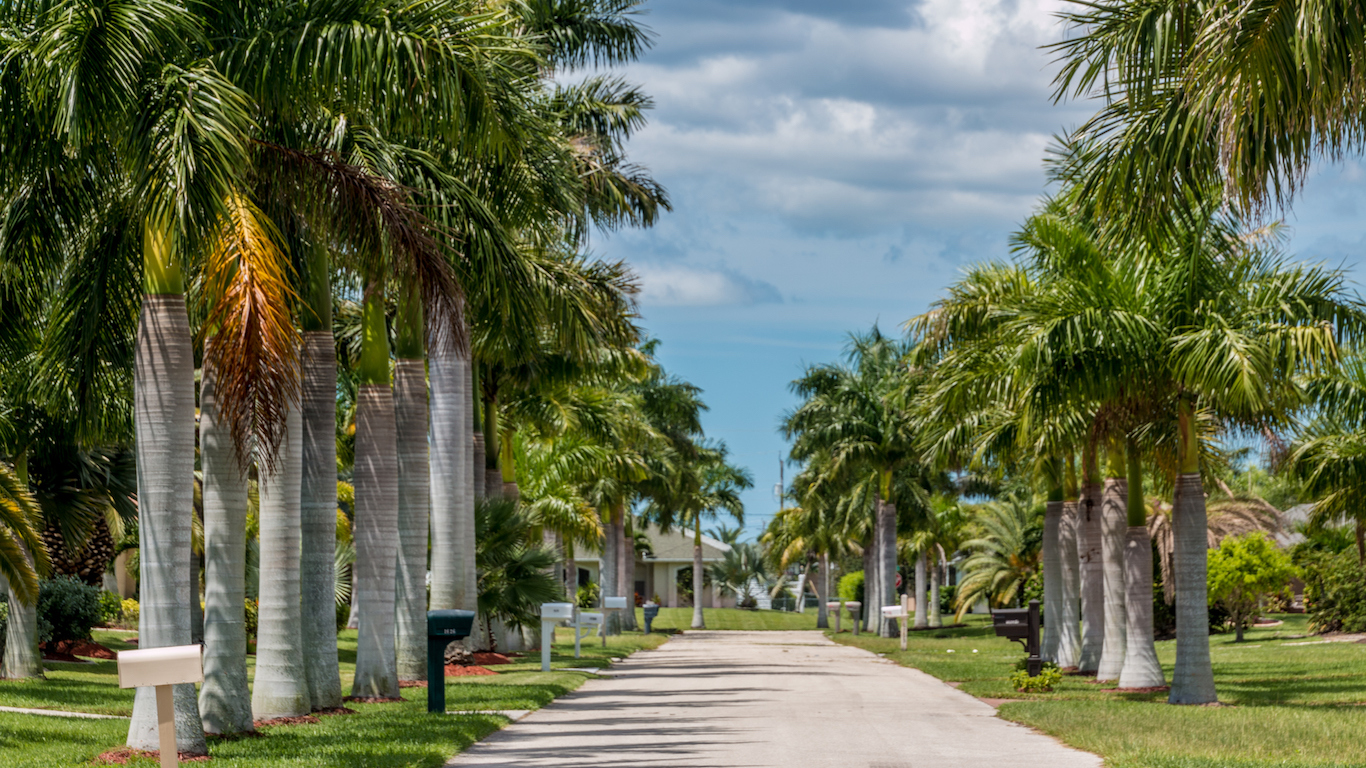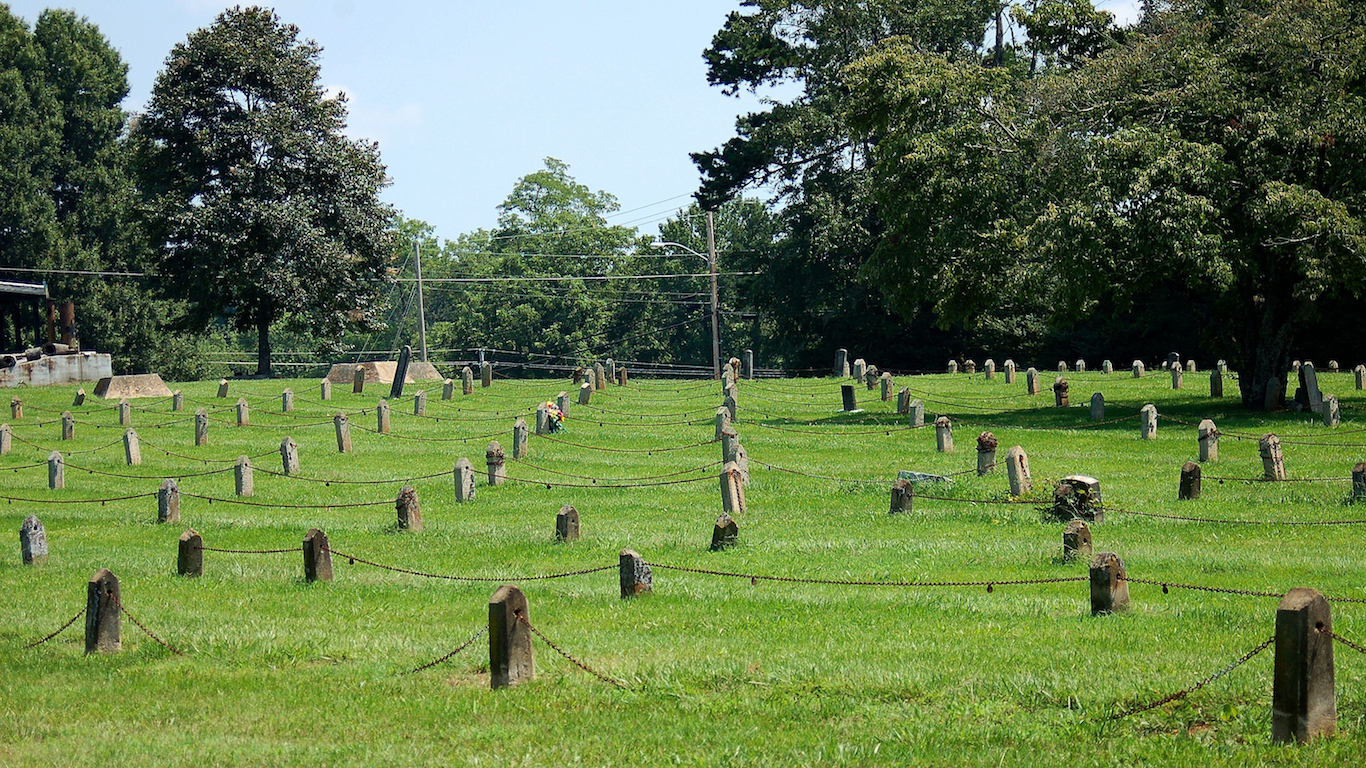Special Report
Cities With the Highest Risk of Heart Attack

Published:
Last Updated:

Heart disease is the leading cause of death in the United States, accounting for one out of every four deaths each year. Some estimate the costs of heart-related health problems will rise to as high as $3.6 trillion annually within a decade. Cardiovascular problems can lead to heart attacks, which range from undetectable, minor incidents to heart failure and death. The prevalence of heart disease varies considerably across the United States.
24/7 Wall St. reviewed the incidence of heart attack in 190 U.S. metropolitan areas. We examined the percentage of adults in each area who have been told by a medical practitioner that they have had a heart attack. These data came from “2015 Community Rankings for Incidence of Heart Attack,” a report from Gallup-Healthways. Charleston, West Virginia leads the nation as the city where the highest share of adults have a history of heart attack.
[in-text-ad]
Ten of the 15 cities with the highest prevalence of heart attack are located in the Southern United States. In a study tracing heart disease mortality from 1973 to 2010 that was published in March, CDC researchers found that the geographic patterns of heart-related deaths have shifted dramatically. The highest heart disease mortality 40 years ago was concentrated in the Northeast. Today, the highest concentration has shifted to the South.
Click here to see the cities where the most people have heart attacks.
Click here to see the cities where the fewest people have heart attacks.
Dr. Matthew Ritchey is an epidemiologist with the Division for Heart Disease and Stroke Prevention at the Centers for Disease Control and Prevention. In an email to 24/7 Wall St., Ritchey said “The consistent progression southward over the past few decades suggests that the pattern is not random – and could be attributed to geographic differences in community-level prevention and treatment opportunities.”
Click image above to enlarge
Gallup’s report highlighted the heavy toll heart disease takes on individuals, families, and caregivers. Individuals with a history of heart attack are considerably more likely than those who have never been diagnosed to miss work and be admitted to a hospital, for example. The average American reports seven physically or mentally unhealthy days in a given month. Of the 15 metros with the highest prevalence of heart attacks, 13 report greater average numbers of unhealthy days in a month.
Certain behaviors and health conditions known to increase the risk of heart attack tend to be relatively common in the areas with the highest incidence of heart attacks. Ritchey noted the prevalence of heart attacks largely depends on “the degree of heart attack risk factors a community has, which include poor blood pressure control, high cholesterol levels, smoking, obesity and physical inactivity.”
The percentage of adults who smoke in 11 of the 15 metro areas on this list exceeds the national adult smoking rate of 17%. Similarly, the obesity rate in eight of the 15 areas exceeds 30%, higher than in most metropolitan areas.
A range of socioeconomic factors appear related to a high prevalence of heart attack. Just as high educational attainment in a population often accompanies positive health outcomes, low educational attainment is often tied to poor health outcomes. Without a college degree it can be difficult to earn a decent wage — income needed for medical expenses, accessing exercise venues, alleviating stress from finances, etc.
To identify the cities where the lowest percentage of adults have had heart attacks, 24/7 Wall St. examined “2015 Community Rankings for Incidence of Heart Attack,” a Gallup-Healthways report that reviewed 190 U.S. metropolitan areas. Gallup’s survey was based on 353,983 telephone interviews with U.S. adults across all 50 states and the District of Columbia and was conducted from January 2, 2014 to December 30, 2015. Participants were asked, “Have you ever been told by a physician or nurse that you have had a heart attack?” The percentage of adults with high blood pressure, high cholesterol, a history of diabetes or depression, as well as the obesity rate also came from Gallup. Median household income, poverty rate, and educational attainment came from the U.S. Census Bureau’s 2015 American Community Survey. The smoking rate came from County Health Rankings and Roadmaps.
These are the cities with the highest risk of heart attack.

15. Cape Coral-Fort Myers, FL
> Pct. who have had a heart attack: 6.2%
> Obesity rate: 26.5%
> Smoking rate: 16.4%
> Median household income: $50,651
One of the most important factors in heart attack prevention is maintaining healthy cholesterol levels. In the Cape Coral-Fort Myers metro area, 32.5% of adults have high cholesterol, one of the largest shares of any metro area. In health-related risk factors, however, Cape Coral residents rank relatively favorably. Just 10.1% of adults have diabetes, and 26.5% are obese — smaller shares than in most major metropolitan areas.
[in-text-ad]
Many Cape Coral residents may be at a higher risk of heart attack regardless of their health. Heart attacks are far more prevalent in older age. Roughly 80% of all heart disease deaths nationwide occur in Americans 65 and older. Cape Coral is one of the metros with the oldest populations in the country. More than one in four residents are 65 and older, among the highest concentrations of any city.

14. Ocala, FL
> Pct. who have had a heart attack: 6.3%
> Obesity rate: 24.6%
> Smoking rate: 17.4%
> Median household income: $40,050
By many measures of cardiovascular health, Ocala residents are at a greater risk of heart attack than the majority of U.S. metro areas. The American Heart Association estimates that adults are two to four times as likely to die of a heart attack or stroke if they have diabetes, a condition which affects 15.0% of Ocala adults. Additionally, 37.8% have high blood pressure, and 32.8% have high cholesterol — some of the largest shares nationwide. An estimated 6.3% of Ocala adults have had a heart attack, one of the largest shares of any city.
The prevalence of cardiovascular disease increases dramatically with old age, and about four out of every five of all people who die from heart disease nationwide are 65 and older. In the Ocala metro area, 28.3% of residents are 65 and older, compared to the 14.9% share across the nation who are senior citizens.

13. Hickory-Lenoir-Morganton, NC
> Pct. who have had a heart attack: 6.3%
> Obesity rate: 34.9%
> Smoking rate: 19.4%
> Median household income: $40,380
The Hickory-Lenoir-Morganton metro area is one of many relatively poor, rural places where residents are at an increased risk of heart attack. The typical Hickory household earns $40,380 annually, far less than the $55,775 national median household income. Physical activity can help control weight, blood pressure, and cholesterol levels, potentially reducing the risk of heart disease. However, fewer than three in five Hickory residents have access to opportunities for physical activity.
In the Hickory-Lenoir-Morganton metro area, 34.9% of adults are obese, 38.8% have high blood pressure, and 30.1% have high cholesterol — some of the largest shares nationwide. Additionally, 16.8% have diabetes, which more than doubles the risk of heart attack or stroke in adults.

12. Lakeland-Winter Haven, FL
> Pct. who have had a heart attack: 6.4%
> Obesity rate: 33.6%
> Smoking rate: 17.2%
> Median household income: $44,061
By many measures of cardiovascular health, residents of the Lakeland-Winter Haven metro area are at a relatively high risk of heart attack. More than one in three adults are obese, which can cause fatal strain on the heart. An estimated 6.4% of adults have experienced a heart attack, the 12th largest share of any metropolitan areas surveyed by Gallup.
[in-text-ad]
Americans 65 and older are more than twice as likely to experience a heart attack than younger Americans. Nearly one in five Lakeland-Winter Haven residents are 65 and over, one of the highest concentrations nationwide. Additionally, 15.3% of adults in the metro area have diabetes, close to the largest share in the country. According to the American Heart Association, at least 68% of Americans with diabetes over 65 die of heart disease.

11. Burlington-South Burlington, VT
> Pct. who have had a heart attack: 6.5%
> Obesity rate: 25.5%
> Smoking rate: 13.4%
> Median household income: $66,807
By several measures, Burlington is unique on this list. Notably, unlike most areas with a high incidence of heart attack, relatively few Burlington residents rate their own health poorly. Less than 10% of people report fair or poor health, the only city on this list with such a low share and one of the lowest such percentages of U.S. cities.
The percentage of adults in the metro area who report excessive drinking, at 23%, is nearly the highest nationwide. While most of the cities with the highest incidence of heart attack report relatively low excessive drinking, the higher level of drinking in Burlington may partially explain heart problems among some city residents.

10. Kingsport-Bristol-Bristol, TN-VA
> Pct. who have had a heart attack: 6.8%
> Obesity rate: 31.9%
> Smoking rate: 22.6%
> Median household income: $41,206
Less than two in three Kingsport-Bristol-Bristol residents have access to opportunities for physical activity. While the American Heart Association recommends at least 30 minutes of moderately intense exercise five days a week or more, 34% of Kingsport adults report engaging in no physical activity whatsoever, the sixth highest inactivity rate in the country. Regular exercise can help control blood pressure and cholesterol levels, which help lower the risk of heart attack. In Kingsport, 40.8% of adults have high blood pressure, and 32.4% have high cholesterol, each close to the highest shares among major U.S. metro areas.

9. North Port-Sarasota-Bradenton, FL
> Pct. who have had a heart attack: 7.0%
> Obesity rate: 22.3%
> Smoking rate: 14.9%
> Median household income: $53,698
In the North Port-Sarasota-Bradenton metro area, 21.3% of adults do not exercise regularly, and 22.3% are obese — each lower shares than most metropolitan areas, and particularly among metro areas with high heart attack rates. Additionally, 14.9% of North Port-Sarasota-Bradenton adults smoke, less than the 17.0% national smoking rate. Despite the relatively healthy behavior of its population, 7.0% of the city’s adults have had a heart attack, one of the largest shares in the country.
[in-text-ad]
The high incidence of heart attack in North Port-Sarasota-Bradenton may be due to risk factors beyond the residents’ control. Americans 65 and over, who are at more than twice the risk of heart attack than the rest of the country, comprise 30.5% of the North Port-Sarasota-Bradenton population, the sixth largest share nationwide.

8. Fort Smith, AR-OK
> Pct. who have had a heart attack: 7.1%
> Obesity rate: 38.1%
> Smoking rate: 22.7%
> Median household income: $41,040
Residents of poor, rural areas often lack the access to health care that can help lower the risk of cardiovascular disease and related conditions. In the Fort Smith metro area, 20.5% of residents live in poverty, and just 57.7% have adequate access to opportunities for physical activity — each far worse than the national poverty and access rates.
Close to one in three Fort Worth adults do not exercise regularly, one of the largest shares among major metropolitan areas. Lack of physical activity can significantly increase the risk of obesity and high blood pressure, both of which affect approximately two in five Fort Worth adults. An estimated 7.1% of adults in the metro area have had a heart attack, one of the largest shares nationwide.

7. Chico, CA
> Pct. who have had a heart attack: 7.1%
> Obesity rate: 36.7%
> Smoking rate: 15.0%
> Median household income: $45,644
While by many measures of cardiovascular health the population of Chico is at a relatively low risk of heart disease, 7.1% of adults in the metro have suffered a heart attack — one of the largest shares nationwide. Just 27.2% of Chico adults have high blood pressure, 19.5% have high cholesterol, and 9.9% have diabetes, far lower shares than in a majority of U.S. metro areas.
One partial explanation for the high incidence of heart attack in Chico may be the high prevalence of obesity in the metro area. An estimated 36.7% of Chico adults are obese, nearly the largest share of any city surveyed by Gallup. According to the World Heart Federation, one in five cases of coronary artery disease — the most common heart disease — is attributable to being overweight.

6. Lake Havasu City-Kingman, AZ
> Pct. who have had a heart attack: 7.2%
> Obesity rate: 25.6%
> Smoking rate: 20.0%
> Median household income: $40,908
Elderly residents are the most likely age group to report having had a heart attack. This may help explain the Lake Havasu City-Kingman metro area’s high rate of heart attacks, as 27.5% of area residents 65 and over, one of the highest shares of all U.S. metro areas.
[in-text-ad]
Regular exercise is one way to help reduce the risk of heart ailments and improve overall health. Nearly one-third of Lake Havasu City area residents do not exercise during their leisure time, well above the 23% of people nationwide who report such sedentary lifestyles. The low level of physical exercise may also be due to the poor access to exercise venues in the metro area. Less than 65% of the population has access to opportunities for physical activity, much less than the national percentage of 84%.

5. Youngstown-Warren-Boardman, OH-PA
> Pct. who have had a heart attack: 7.4%
> Obesity rate: 35.1%
> Smoking rate: 20.7%
> Median household income: $43,127
In the Youngstown-Warren-Boardman metro area, 36.6% of surveyed adults have high blood pressure, 33.4% have high cholesterol, and 15.1% have diabetes — some of the largest shares in the country. For adults with both high blood pressure and diabetes, the risk of cardiovascular disease is twice as high as for those without these conditions. An estimated 7.4% of adults in the metro area have suffered a heart attack, the fifth largest share of all major metropolitan areas.
In addition to heart disease, Youngstown residents are at an increased risk of asthma and other lung problems. Youngstown-Warren-Boardman has some of the worst air quality in the country. Studies have also suggested a link between air pollution and heart disease.

4. Huntington-Ashland, WV-KY-OH
> Pct. who have had a heart attack: 7.7%
> Obesity rate: 31.8%
> Smoking rate: 22.9%
> Median household income: $42,237
Financial stability facilitates maintaining a healthy lifestyle. Financial difficulties can impede recovery in the case of a heart attack, which often comes with costly medical bills in the thousands of dollars. When it comes to finances, the Huntington-Ashland metro area is no different than other metros with a high incidence of heart attack — area residents are not especially wealthy. More than 20% of people in the area live in poverty, one of the higher poverty rates nationwide.
A college education helps ensure a higher income, and college-educated adults are generally more likely to make healthier lifestyle choices. Less than 20% of adults in the Huntington area have a college degree, one of the lowest percentages in the nation.

3. Duluth, MN-WI
> Pct. who have had a heart attack: 7.7%
> Obesity rate: 29.2%
> Smoking rate: 19.2%
> Median household income: $50,566
While by many measures of cardiovascular health the population of the Duluth metro area is at a relatively low risk of heart disease, 7.7% of residents have suffered a heart attack — one of the largest shares nationwide. Just 28.4% of Duluth adults have high blood pressure, 24.1% have high cholesterol, and 9.6% have diabetes — smaller shares than most of surveyed metro areas.
[in-text-ad]
One part of the explanation for the high incidence of heart attack in Duluth may be the high prevalence of depression among city residents. An estimated 23.5% of Duluth adults are depressed, the fifth largest share among cities surveyed by Gallup. Depression can often lead to many health behaviors that increase the risk of heart attack. Studies have also shown people to be more likely to develop depression after experiencing a heart attack or undergoing cardiovascular surgery.

2. Deltona-Daytona Beach-Ormond Beach, FL
> Pct. who have had a heart attack: 7.9%
> Obesity rate: 29.3%
> Smoking rate: 18.4%
> Median household income: $43,284
Relatively large shares of Deltona area residents engage in behaviors known to increase the risk of heart attack. The adult smoking rate of 18.4%, for example, is among the higher rates compared with other U.S. metros. Like a number of other cities with a high incidence of heart attack, Deltona-Daytona Beach-Ormond Beach residents have relatively low incomes, which for some residents likely hinders efforts to stay healthy.
Because the Americans 65 and older are twice as likely to have had a heart attack, a high concentration of the age group in a city can explain a high incidence of heart attack. This appears to be the case in the Deltona area, where nearly 25% of residents are 65 and older, well above the national proportion of 14.9%.

1. Charleston, WV
> Pct. who have had a heart attack: 8.8%
> Obesity rate: 40.6%
> Smoking rate: 23.6%
> Median household income: $42,526
No city has a higher lifetime incidence of heart attack than Charleston, where 8.8% of adults have survived a heart attack. Close to one in four area adults are smokers, and more than two in five are obese — each among the highest proportions of any U.S. metro area. Since smoking and obesity increase the risk of heart disease substantially, these relatively common lifestyles in Charleston likely helps explain the high incidence of heart attack among the area’s population.
Like in many other cities where heart attacks are more common, Charleston residents are not especially wealthy. The typical household earns $42,526 annually, well below the national median income of $55,775 annually.
Retirement planning doesn’t have to feel overwhelming. The key is finding expert guidance—and SmartAsset’s simple quiz makes it easier than ever for you to connect with a vetted financial advisor.
Here’s how it works:
Why wait? Start building the retirement you’ve always dreamed of. Click here to get started today!
Thank you for reading! Have some feedback for us?
Contact the 24/7 Wall St. editorial team.